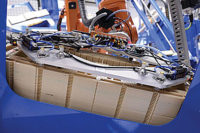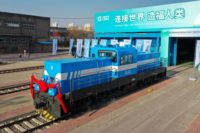At the recent Geneva Motor Show, vehicle electrification was a leading topic of conversation. While automakers aren’t giving up on the good-old internal combustion engine just yet, they’re investing billions of dollars to develop fully electric systems that are reliable, safe and cost-effective to assemble.
Most talk about electric vehicles today tends to focus on the battle to mass-produce a mid-priced car for the mass market. The two leading contenders are General Motors and its Chevy Bolt vs. Tesla Inc. and its long-awaited Model 3.
GM recently announced that it plans to boost production of the Bolt at its Orion Assembly Plant in Michigan. Meanwhile, Tesla has been struggling to ramp up its assembly line in Fremont, CA.
But, there’s another major competition heating up in the less-glamorous commercial vehicle market. Tesla recently unveiled plans to develop a heavy-duty truck called the Semi. It will feature four independent electric motors attached to rear axles to provide maximum power and acceleration while hauling semitrailers.
With a full 80,000-pound load, Tesla claims that its all-electric vehicle will achieve 0 to 60 mph in 20 seconds vs. 60 seconds for a traditional diesel-powered truck. It also will not require any shifting or clutching, resulting in smooth acceleration and deceleration.
Tesla is still a few years away from producing the Semi. However, many truck manufacturers are busy developing electric platforms of their own.
“Market-leading commercial vehicle manufacturers, strategic suppliers and well-funded start-ups are racing to deliver a plethora of different battery-electric solutions, from delivery vans to big rigs and specialty vehicles,” says Susan Beardslee, senior analyst at ABI Research Inc.
“Upstarts like SEA Electric and Thor Trucks are challenging industry leaders and going head to head with firms like Daimler Trucks and Volvo Trucks for market share in key verticals and geographies,” adds Beardslee.
“Heavy-duty vehicles are drawing the most attention, [but] the best near-term use cases stem from shorter, consistent routes, such as last-mile delivery and passenger buses,” explains Beardslee. “Start-ups like Arrival, Chanje and Workhorse are battling for a share of the lucrative last-mile delivery market, fueled by the rush of e-commerce.”
Last year, Volkswagen acquired 17 percent of Navistar to add medium-duty electric vehicles to its vast portfolio. The German automaker plans to invest $2 billion over the next five years to develop electric power trains for it truck division.
Traditional suppliers, such as BorgWarner and Cummins, hope to grab a piece of the pie. They’re scrambling to develop components needed to generate electric power. Most of the R&D efforts are focusing on batteries, electric drive motors, generators and power electronics.
“While current penetration of consumer auto electric vehicles largely remains in the lower single digits, a combination of factors is propelling commercial usage,” says Beardslee.
Most electric vehicle activity is centered on the lucrative Class 6 and Class 7 truck market, which includes garbage trucks and vehicles that are used to distribute beverages, food and other products in urban settings.
One company that plans to be a major player in that market is Volvo Trucks. Later this year, it will start assembling its new FL Electric truck in Europe.
The 16-ton vehicle features an electric motor capable of generating 175 hp. It can be configured with different lithium-ion battery packs for a capacity between 100 and 300 kilowatt hours and a range of up to 186 miles.
“Urban distribution and other pick-up and delivery applications are a starting point for battery-powered electric trucks,” says Goran Nyberg, president of Volvo Trucks North America. “But, we envision broader deployment of [the technology] for freight movement as technologies and the market mature.”




